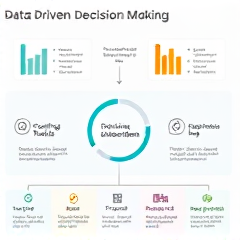Review of the book "Explosion Growth. How modern fast-growing companies make a successful breakthrough" by Morgan Brown, Sean Ellis
The pages of the book are spinning with not just abstract advice, but:
- Turnkey tools — from client retention mechanics to sophisticated growth-hacking tricks.
- Cases from the workshops of Uber, LinkedIn and Airbnb.
- Without sentimentality, the innermost secrets of explosive growth are revealed.
The methodology is universal — it is revered by both startups and giants like IBM.
However, the book almost deliberately avoids the dark side of the reckless pursuit of growth.
If you have an itch to not just read "about business", but to get involved in a real marketing grinder, this edition is just the ticket to the high-speed train, where, alas, there are no brakes.
Key Concepts and Their Analysis

The book's key ideas are presented to the reader not as a dull set of formulas, but as a combat kit for those who are tired of standing still — everything is to the point, everything is on the cutting edge of the moment. The authors don't get bogged down in abstractions:
- Working schemes used by real market players — Airbnb, LinkedIn, Uber.
- The speed of decision-making is measured not in months, but in days, and sometimes even hours.
- The principle of multiple experiments and interdisciplinary teams.
- The approach to growth is a constant "reboot" of hypotheses.
I was personally won over by the fact that the methodology doesn't divide companies into "big" and "small" — the rules of the game are the same for everyone: test quickly, change boldly, don't be afraid of failures, or you'll be left behind.
Who is the book for
When you pick up this book, you immediately understand: this is not a reading for a idle mind, here every paragraph is a challenge for those who are used to "living by the manual".
The target audience is clear - those who are not satisfied with stable but sluggish dynamics:
- marketers
- managers
- startups
- product evangelists
who are tired of listening to mantras about "organic growth" and want to finally see how in a real business you can double your active audience in a month:
- double the active audience
- get the product to the top of the App Store
instead of endlessly wandering in the middle. For managers who dream of implementing a rapid test culture, rather than gathering a team for a monthly "flight analysis" just for the sake of it, there are many proven recipes here - from sprints with specific KPIs to cases where Facebook tested dozens of hypotheses in a week without fear of failure.
Surprisingly, even large corporations like Microsoft or Walmart find a source of fresh air in these approaches: because if you don't catch the wave of change, sooner or later you'll find yourself among those who have already been forgotten in the market.
In general, if you're tired of reading another treatise on "company mission" and want a tool that really moves the numbers up - you're in the right place.
About the author and his significance in marketing

When you start to analyze the contributions of the authors of this book, it's impossible to overlook the figure of Sean Ellis — a person whose name has long become a kind of password to enter the exclusive club of those who really move the industry forward in the marketing environment.
Ellis is not an armchair theorist, but someone who stood at the origins of the hypergrowth of such giants as Dropbox and Eventbrite, and, what's truly important, introduced the very concept of “growth hacking”, which is now being chased by both startups and heavyweights from the Fortune 500 list.
His approaches are not just beautiful diagrams in presentations, but toolkits that once allowed Airbnb to increase its user base by tens of percent in a matter of weeks, and LinkedIn to test hypotheses so quickly that competitors could only raise an eyebrow.
In tandem with Morgan Brown, a practitioner with an impressive portfolio of real-life cases, Ellis proves that growth is not a mysterious alchemy, but a repeatable process.
And here I catch myself feeling respect: unlike the authors of hundreds of empty bestsellers, these two don't just collect other people's stories, but honestly share what they themselves implemented and were responsible for the results — in companies where a mistake costs millions, and success is measured not by likes, but by real users and profit.
The Place of the Book in Modern Marketing Literature
If we try to fit the significance of this work on the shelf of modern business literature, it probably stands out from the dull row of books with advice for "practical business owners" and "weekend startuppers". There's no usual regurgitation of copy-paste and retelling of others' successes here:
- every tool
- every system
discussed has been put through the mill of real market battles — whether it's Airbnb's hurricane experiments or LinkedIn's laser precision. The authors don't get bogged down in abstract theories, but instead give readers specific step-by-step methodologies that have been implemented in IBM and Microsoft, with results measured in double-digit percentage growth in the client base per quarter.
Unlike many trendy but useless "methodologies", the focus here is not on pretty slogans, but on how to assemble a team, launch dozens of hypotheses, and gain actual market growth, not just empty fuss.
Against the backdrop of classics like Eric Ries or the authors of the scrum methodology, this work doesn't lag behind in depth, but wins due to its fresh approach and abundance of real-life cases from the front line, rather than polished stories like "everything worked out on its own". Reading it, you feel a direct hit on the pain points of modern business — not studying for the sake of a tick, but an instruction manual for those who want to be one step ahead of the rest tomorrow.
| Method | Effectiveness | Application |
|---|---|---|
| Method A | High | IBM, Microsoft |
| Method B | Low | Not applied |
Relevance of the publication at the moment

In an era when the market resembles a high-speed highway without limits, the proposals of the authors are not just timely — they are necessary as air for those trying not to fly off the road.
Today's realities require:
- Not theoretical reasoning about "how good it would be";
- Instructions capable of saving the project from the next wave of turbulence.
When even giants like Microsoft and IBM are forced to rebuild their processes to survive, advice tested on LinkedIn and Airbnb sounds not like another "we should try", but like a direct prescription for action.
The approach with quick hypotheses and multidisciplinary teams is not just fashionable now — it has become the standard for survival:
- Otherwise, competitors armed with similar methods will overtake you tomorrow.
Reading these chapters in 2025, you catch yourself thinking that the authors hit the nervous system of the time — when the speed of implementation and the accuracy of experiments decide whether the company will have the next round of funding or be forgotten in a month.
Fundamental Marketing Concepts

In the book, the authors don't waste time on banal explanations of truisms like "the client is always right" - here, the foundation on which all subsequent material is based is a transparent formula:
- data
- team
- hypothesis
- test
Everything is neatly arranged, like in a pharmacy: if you can't quickly launch A/B tests or don't see the point in cross-functional teams, you can safely close the book - it's not for you.
I clearly felt that the usual "bring a friend" and "launch a promotion" are in the past: the authors propose not to rely on guesses, but to build a system in which every action is part of a unified strategy. For example, LinkedIn increased its growth rate just by implementing constant iterations and coordinated interaction between marketers and developers.
There's no talk of vague concepts here - everything is grounded in numbers, in hard indicators. This pragmatism is overwhelming: you either learn to think in categories of "test - result - scaling", or you're out. And what's important, the authors don't romanticize the process - they demand results, not beautiful presentations.
Innovative ideas and modern trends
If the previous chapter convincingly showed the uncompromising rigidity of the approach, here the authors lift the veil on fashionable buzzwords and demonstrate: no magic, just a rock-solid system — and it works on the ground, not in the vacuum of training rooms.
- When Airbnb conducted over 700 A/B experiments in a quarter
- Pinterest changed the parameters of the funnel every week
It became clear to me that “fast means right”. This is where the essence of fresh trends lies: marketing is now not about intrusive creativity, but about thinking like a scientist with a stopwatch and calculator.
Here, it's not fashionable to draw logos, but to put hypotheses into battle, like in sprint competitions. Everything that can be measured is measured, and what cannot be counted is discarded as unnecessary.
A reader accustomed to the old song about “brand awareness” risks being left in the dust:
- IBM
- Uber
Everyone has long since switched to the rails of constant testing of their ideas for strength with real metrics, not just beautiful stories for investors.
I confess, this approach wins me over — no unnecessary fluff, just bare benefits, whose drive is contagious and forces one to rethink their own work habits.
Applicability of Concepts in Modern Business
The principles discussed go far beyond fleeting trends — this is not another attempt to “collect life hacks under one cover,” but a real working toolkit that has already become a standard for companies that count every penny.
Here, the authors don’t waste time on abstractions: among the first, they clearly show how systematic work with hypotheses and microscopic analytics can not only support but radically accelerate growth.
Take LinkedIn, for example, where the implementation of rapid experimentation cycles made it possible to increase the engagement coefficient in a year — and this is not an advertising trick, but dry facts from reports.
Even giants like Microsoft or WalMart, seemingly rigid and clumsy, were forced to rebuild their processes to a rhythm that previously allowed only startups with burning eyes to survive.
Reading these cases, you can’t help but think: if such giants were not afraid to revise their foundations for the sake of growth, then maybe it’s time for us to stop being afraid of making mistakes and start measuring everything — down to how many seconds a user looks at the “Buy” button?
| Company | Method | Result |
|---|---|---|
| Rapid Experimentation | Engagement | |
| Microsoft | Restructuring Process | Adaptation to new realities |
| WalMart | Analytics and Optimization | Increased Efficiency |
Case studies and examples from real business
When real stories appear on the pages of the book — for example, about how Airbnb emerged from stagnation to daily growth in bookings over six months with a tiny team and dozens of mini-experiments, or how Uber implemented end-to-end analytics not just to boost numbers, but to literally build a new user behavior logic based on data — you realize that this is not about beautiful theory. This is about sweat and sleepless nights, when every percentage is not an abstraction, but a life buoy.
- The authors are not shy about showing failures as well: the IBM case, where four months of testing seemingly yielded no results, but ultimately allowed them to reassemble the onboarding process and reduce the outflow of new clients by a third.
- Such examples have a sobering effect — not a hint of glossy reality, just the honest kitchen of business, where success is made up of thousands of non-obvious steps and the ability to acknowledge one's mistakes.
- You read and catch yourself feeling envious: why can't we do it like that yet?
Strengths of the publication
When considering the strengths of this book, it's impossible to overlook its utilitarianism: the authors, like experienced mechanics, have broken down not only the successes but also the mistakes made in real, working business models. Instead of vague slogans, there are clear checklists where every action, whether it's launching a three-day beta test or a weekly review of data slices, is embedded in a specific business process.
- The book doesn't indulge in excessive academism: no theory for theory's sake, only what can be applied here and now, without lengthy approvals and cumbersome budgets.
- A working instruction: which is easy to "try on" your own project, regardless of its scale or niche.
- An approach to team dynamics: the authors never tire of emphasizing the value of synergy between analysts, marketers, and product managers.
- Fresh case studies: illustrate this not with words, but with examples from companies that are familiar to everyone.
As you read, it's like receiving a personal masterclass from those who have been through fire and water themselves, rather than just retelling someone else's stories.
Critical Analysis
However, despite the impressive practicality and abundance of examples, one cannot turn a blind eye to a certain one-sidedness in the presentation: the authors are so carried away by operational techniques that in their pursuit of “quick wins” they sometimes ignore the underlying causes of failures.
In places, it is noticeable that behind the facade of universal “growth hacks” lies an elementary lack of attention to long-term sustainability — as if there is an excessive focus on the short distance.
For example, when it comes to implementing automation or weekly sprints, the emphasis is on speed and scalability, but the risks are hardly discussed:
- Loss of product uniqueness
- Team burnout
The examples given of Uber and Facebook are certainly impressive, but one gets the impression that against their background, other, less loud, but no less instructive stories of failure are being obscured.
The book undoubtedly invigorates and energizes, but it also fills me with cautious skepticism: doesn’t everything look too tempting on paper, if in reality even giants like IBM and Microsoft paved their way to success not only with life hacks, but also with a series of difficult compromises?
Tools and techniques for practical use
Claimed author's techniques, such as daily metrics, integrating A/B tests into every second task, and implementing “hypothesis — experiment — scaling” as a new norm of corporate life, look on the pages like a magic wand for any startup. But behind the brilliant wrapper lies a banal truth: the tools from the book work only where the team is ready to live in a mode of eternal adrenaline marathon.
The call for total cross-functionality and the non-stop search for a “point of growth” sounds tempting, but in practice, it turns into an exhausting race — recall, for example, how the weekly testing cycles are расписаны in one of the chapters, where literally a couple of working days are allotted for the preparation of the MVP, and failure is written off as “useful experience”.
It's not far to slip into the culture of eternal “storm”, where the creative spark burns out faster than the first result appears. I wouldn't blindly copy such techniques, because even in giant companies, whose success stories are lined up here like trophies, the implementation of such tools was accompanied not only by a firework of victories but also by a considerable number of internal crises, which the authors, it seems, don't mention.
| Method | Advantages | Disadvantages |
|---|---|---|
| Daily metrics | Simplify analysis | Can cause stress |
| A/B tests | Optimize solutions | Require time |
| Hypothesis — experiment — scaling | Structured approach | Risk of failure |
Popularity of the real edition

This publication appears on bookstore shelves and in business literature collections with surprising frequency — and not just because its cover screams about the “secret to million-dollar success”; rather, the word-of-mouth effect has kicked in among those seeking quick solutions to the eternal headache of growth.
It's no coincidence that discussions about the book on business Telegram channels and specialized forums garner hundreds of responses — readers argue, share the pain of implementation, and some even post screenshots of their killer “sprints” and failure charts, inspired by chapters from the book.
There's no magic pill here, but the irony is that even skeptics who dismiss the “testing for testing's sake” methodologies acknowledge: this approach is now featured in the job descriptions of many middle managers at large internet companies.
In a way, the book has become a marker of ambition and internal pressure: if you haven't read it, you're not in the know. Although personally, I struggle to separate the hype surrounding it from the real impact — because behind the loud words often lies a banal industrial fad for “quick wins”, which, as the experience of Airbnb has shown, can turn into disappointment for teams unprepared for such a grind.
- Book discussions in Telegram channels
- Readers' disputes and exchange of experience
- Approach featured in job descriptions
- Risks of “quick wins”
Other works by the author
If you turn the page and go beyond the discussed bestseller, it becomes obvious: Sean Ellis and Morgan Brown have dozens of publications behind them, and each of them is a separate layer for reflection. The same Ellis, for example, made a notable statement in “Hacking Growth”, where he first crystallized a systematic approach to the accelerated development of digital products — and it was there that the idea of allocating a separate “growth team” in the business structure was first widely voiced, which was later adopted by even such giants as Microsoft and IBM.
- In earlier publications by the authors, you can find tough analyses of failures.
- Analytics of the failure of implemented features in Pinterest or a case with a failed hypothesis in LinkedIn.
- The authors' honesty: they will break down why the sprint failed.
- They are not afraid to state the exact figures of user churn or “burned” budgets.
Reading their previous works, you catch yourself thinking that the authors are not following the path of banal copy-pasting: each time they bring to light new pain points that concern not only venture-backed startups but also managers from the corporate world. And here, against the background of their previous works, the book under consideration is rather a logical continuation — a kind of quintessence of everything they have gathered bit by bit from real-life cases of Airbnb, Facebook, or Uber, but with a slightly greater emphasis on pragmatism and less on theorizing.
Comparison with Other Works by the Authors
If we look at the previous works of this duo, it becomes apparent that their approach is evolving, much like software, where each new version eliminates bugs and adds fresh features.
In their early articles for specialized publications, I was always won over by their utmost honesty: the authors are not afraid to lay out their real failures, whether it's:
- a clear miscalculation with the implementation of a new feature on Pinterest
- a specific failure of a test hypothesis on LinkedIn, where the losses were measured not in abstract "downsides" but in quite tangible user churn
Against this backdrop, the new book looks like the result of years of selecting successful techniques: if earlier they tended to discuss theory more and didn't shy away from "post-mortem analyses" in the old-school style, now they focus on practical tools that can be implemented as early as tomorrow.
Unlike their previous work, where one had to fish out the essence between the lines, here everything is neatly laid out - from the structure of project teams to step-by-step scenarios for rapid testing.
It feels like the authors have finally tired of abstract reasoning and decided to leave the reader with only what really works in practice.
| Tool | Advantages | Disadvantages |
|---|---|---|
| User-friendly interface | Possible implementation errors | |
| Wide audience | Risk of user churn |
Similar literature by other authors
If we put aside this particular work, there are plenty of competitors on the bookshelves ready to fight for the attention of a pragmatic reader:
- Ryan Holiday with his "Obstacle Is the Way"
- Eric Ries with the classic "Lean Startup"
It seems that they have long since staked out a place on the list of must-read literature for marketers and entrepreneurs. However, when you compare them to the work of Brown and Ellis, it becomes clear that the latter have much more "muscle" in the realm of practical application.
Despite having vivid examples like Dropbox and Hotmail, Holiday's work is still more focused on philosophy and general principles - after reading it, you get a slight feeling that you've been told how to dream correctly, but haven't been given a treasure map.
Ries provides a very detailed analysis of hypotheses and iterations, but sometimes you can't help but want to shout: "But where are the real business failures, where's the blood?"
Against this backdrop, the book by Brown and Ellis wins due to its surgical precision: no fluff, just concrete steps backed by numbers and the experience of companies like Airbnb and Uber, where failure is measured not by reputational costs, but by quite literal six-figure sums.
That's why, when you come back to similar literature, you realize that such clear "survival guides" are still hard to find on the market.
